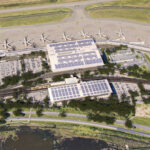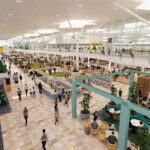Major works are under way to ensure the airport upgrade its security screening equipment to comply with federal standards by the end of 2025, according to the airport.
“After three decades of service, it’s well and truly time for a transformation, ensuring it’s ready to welcome the world for years to come,’’ says airport CEO Gert-Jan de Graff.
“This building is worth billions of dollars to Queensland’s tourism economy and jobs every year.”
The work at the International Terminal is part of the $5 billion Future BNE transformation which also includes upgrades to the Domestic Terminal, construction of Terminal 3, and extensive commercial, retail, and industrial projects.
Security Screening and Passport Control operations at Brisbane Airport’s International Terminal will move up a level to an atrium on Level 4.
Among the enhanced capabilities are new Computed Tomography (CT) screening equipment for passengers and baggage that will allow passengers to leave items like laptops in their bag and have other loose items screened with their cabin bag.
The new equipment will also increase the speed at which passengers will pass through the screening point with greater accuracy, reducing the need to rescreen bags.
The same technology is being installed in the Domestic Terminal and is part of the single largest airport deployment of Rapiscan Systems in South-East Asia.
There will also be new advanced self-service bag drops and check-ins provided by Amadeus technology to reduce queues.
“The first new-generation check-in row is already up and running, and the feedback from travellers and airline staff has been fantastic. It’s a giant leap from the 1990s to now,” says Mr de Graaff.
Staged construction is under way in the International Terminal baggage area on a steel frame mezzanine to house a new, energy-efficient, conveyor system and baggage security screening equipment. Brisbane Airport’s duty free area is also set to nearly double in size.
On the terminal’s apron, a network of charging equipment for ground support equipment (GSE) will be installed. GSE at airports include pushback tugs, belt loaders, cargo loaders, and baggage tugs used to service aircraft.
“Not only will this convert vehicles from fossil fuels to sustainable sources but it will also make the apron a quieter workplace for the hundreds of people who work loading and dispatching aircraft every day, as well as passengers,” says Mr de Graaff.
Th airport says it will carefully stage the project over 20 phases to minimise disruption for passengers and airlines; construction is due to end in 2027.
“As anyone who has ever renovated a house will know, construction comes with challenges, but we are working to keep impacts to a minimum, while remaining open and catering for up to 20,000 international passengers a day,” Mr de Graaff says.
In the 2024 financial year, the International Terminal welcomed 5.6 million passengers, up 39% on the previous year.
In October American Airlines begins direct flights from Dallas-Fort Worth (Texas) while in December Delta Air Lines starts direct flights from Los Angeles.
Qantas will also shortly begin flights to Manila and Jetstar to Bangkok.












